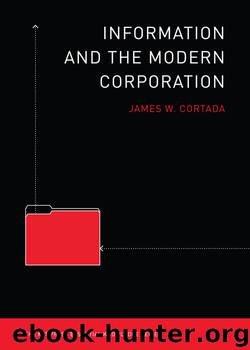Information and the Modern Corporation by James W Cortada

Author:James W Cortada [Cortada, James W.]
Language: eng
Format: epub
ISBN: 9780262297943
Publisher: The MIT Press
Published: 2011-12-21T05:00:00+00:00
5
“Digital Plumbing” in the Modern Organization
All enterprises, regardless of size, have a great deal of computing and communications hardware and software installed. Their employees do, too. There is an inaccurate view which holds that the clutter of technologies is just that—a disorganized hodgepodge of gadgets, desk drawers full of old cell phones and calculators whose batteries died a long time ago, and storerooms full of ancient PCs that someone intends to recycle someday. To be sure, there are multiple generations of equipment and software in use, and there are systems that do not make it easy to move data from one piece of equipment to another, but underneath it all, and behind the scenes, something quite different has been emerging as the “digital plumbing” of the modern organization, in both the public and the private sector, with virtually no exceptions.
The annual expenditure of nearly $4 trillion on information technology, of which about half goes explicitly into the digital infrastructures of organizations, has resulted in some common patterns of deployment. These can lead us to see the networked workplace in new ways. Perhaps most important, IT infrastructures collect and make available an enormous amount of useful information. It is no accident that individuals and organizations have spent tens of trillions of dollars on information and communication technology (ICT) in the past 50 years, or that expenditures on ICT today consume 6–7 percent of the world’s total GDP.
Information Networks for Systems of Systems
In the 1970s, as people started using personal computers, terminals, and big computers in combination to share information, corporate managements began implementing an extended three-prong process. First, they rationalized the use of technology to gain control over expenditures of all types on ICT. Second, they took steps to make the flow of digitized data around the enterprise, the government agency, and (later) the university increasingly effective and ubiquitous. Third, and most recently, a primary objective has been to protect data contained in these systems. By 1980, the humble data-processing manager had been elevated to divisional vice president of Management Information Systems (MIS). By 1990, that individual was an executive—perhaps the corporation’s Chief Information Officer (CIO). The first two classes of management protected networks and data within their divisions. CIOs acquired a mandate almost as broad as that of the Chief Financial Officer (CFO). Beyond their responsibilities for acquiring, protecting, and using hardware and software, CIOs were now responsible for helping all employees use technology in support of their activities as knowledge workers. Information was as valuable as money and inventory, and loss of information was as devastating as usurpation of a patent or industrial espionage. By the early 2000s, IT organizations had gone from consuming 1–1.7 percent of a corporation’s budget to an average closer to 5–9 percent, varying by industry.
We are now at a point where digital infrastructures can be seen as systems of systems—ecosystems made up of processes, not only of hardware and software. An enterprise is made up of collections of processes, and so are the data that each process requires and is a part of—data which are attached to work flows with ICT.
Download
This site does not store any files on its server. We only index and link to content provided by other sites. Please contact the content providers to delete copyright contents if any and email us, we'll remove relevant links or contents immediately.
Hit Refresh by Satya Nadella(8325)
The Compound Effect by Darren Hardy(7540)
Change Your Questions, Change Your Life by Marilee Adams(6632)
Nudge - Improving Decisions about Health, Wealth, and Happiness by Thaler Sunstein(6626)
The Black Swan by Nassim Nicholas Taleb(6179)
Daring Greatly by Brene Brown(5632)
Deep Work by Cal Newport(5446)
Principles: Life and Work by Ray Dalio(5312)
Rich Dad Poor Dad by Robert T. Kiyosaki(5137)
The Myth of the Strong Leader by Archie Brown(4783)
Man-made Catastrophes and Risk Information Concealment by Dmitry Chernov & Didier Sornette(4723)
Big Magic: Creative Living Beyond Fear by Elizabeth Gilbert(4713)
The Slight Edge by Jeff Olson(4711)
Discipline Equals Freedom by Jocko Willink(4626)
The Motivation Myth by Jeff Haden(4518)
Digital Minimalism by Cal Newport;(4501)
Stone's Rules by Roger Stone(4409)
Management Strategies for the Cloud Revolution: How Cloud Computing Is Transforming Business and Why You Can't Afford to Be Left Behind by Charles Babcock(4125)
The Doodle Revolution by Sunni Brown(4031)
